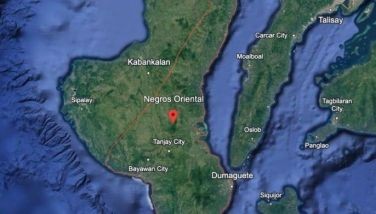USAID stops grant to RP’s AIDS program
July 13, 2001 | 12:00am
The country’s low HIV and AIDS infection rate has prompted the United States Agency for International Development (USAID) to phase out its funding support for the country’s HIV-AIDS surveillance project.
The AIDS Surveillance and Education Project (ASEP) has been regarded as highly successful, but even with the withdrawal of financial support from USAID, it will continue through the efforts and funding of the Department of Health (DOH), local government units, non-government organizations and other agencies.
ASEP, funded with an USAID grant, was initiated in 1993, with the help of the Western Pacific Regional Office of the World Health Organization, to prevent the increase of HIV and AIDS incidence in the Philippines.
ASEP’s activities consisted of serological (blood tests) and behavioral surveillance of high-risk groups as well as education, advocacy and policy campaigns under the Appropriate Technology in Health (PATH) program.
The project was first carried out in Quezon City and Cebu City, and gradually expanded to the cities of Pasay, Iloilo, Baguio, Zamboanga, Cagayan de Oro, General Santos, Angeles and Davao.
It targeted high-risk groups such as registered and freelance sex workers, men who have sex with men, injectable drug users and other special groups.
Despite predictions that the Philippines would become an AIDS hot spot, the HIV infection rate has been at a slow and low level.
To date, there are only about 1,500 HIV-positive Filipinos even after almost two decades of monitoring through the AIDS Registry.
Dr. Ricardo Mateo, resident advisor of the DOH-based National HIV-AIDS Sentinel Surveillance System, attributed the low and slow HIV transmission to the non-extensive network of sexual workers and fewer Filipino males engaging in anal sex.
He added that most Filipinos suffering from sexually transmitted diseases (STDs) are afflicted with the non-ulcerative types (ulcerative types are more predisposed to HIV infection), that there are few injectable drug users, that most Filipino males are circumcised, and that the country’s geography poses natural barriers that limit the spread of diseases.
Health Secretary Manuel Dayrit, however, said the country’s current HIV-AIDS rate should not make concerned agencies and individuals complacent because an epidemic is still possible.
He said the establishment of social hygiene clinics, through the efforts of local government units, to regularly check and monitor commercial sex workers helped a lot in controlling the spread of HIV, AIDS and other STDs.
"It could have been much worse without the social hygiene clinics," he said.
Credit also goes to the early and accelerated multisectoral response to the dreaded disease which was first brought to public attention 20 years ago.
ASEP is set to tap health workers, NGOs and industry heads to further intensity the anti-AIDS campaign.
The AIDS Surveillance and Education Project (ASEP) has been regarded as highly successful, but even with the withdrawal of financial support from USAID, it will continue through the efforts and funding of the Department of Health (DOH), local government units, non-government organizations and other agencies.
ASEP, funded with an USAID grant, was initiated in 1993, with the help of the Western Pacific Regional Office of the World Health Organization, to prevent the increase of HIV and AIDS incidence in the Philippines.
ASEP’s activities consisted of serological (blood tests) and behavioral surveillance of high-risk groups as well as education, advocacy and policy campaigns under the Appropriate Technology in Health (PATH) program.
The project was first carried out in Quezon City and Cebu City, and gradually expanded to the cities of Pasay, Iloilo, Baguio, Zamboanga, Cagayan de Oro, General Santos, Angeles and Davao.
It targeted high-risk groups such as registered and freelance sex workers, men who have sex with men, injectable drug users and other special groups.
Despite predictions that the Philippines would become an AIDS hot spot, the HIV infection rate has been at a slow and low level.
To date, there are only about 1,500 HIV-positive Filipinos even after almost two decades of monitoring through the AIDS Registry.
Dr. Ricardo Mateo, resident advisor of the DOH-based National HIV-AIDS Sentinel Surveillance System, attributed the low and slow HIV transmission to the non-extensive network of sexual workers and fewer Filipino males engaging in anal sex.
He added that most Filipinos suffering from sexually transmitted diseases (STDs) are afflicted with the non-ulcerative types (ulcerative types are more predisposed to HIV infection), that there are few injectable drug users, that most Filipino males are circumcised, and that the country’s geography poses natural barriers that limit the spread of diseases.
Health Secretary Manuel Dayrit, however, said the country’s current HIV-AIDS rate should not make concerned agencies and individuals complacent because an epidemic is still possible.
He said the establishment of social hygiene clinics, through the efforts of local government units, to regularly check and monitor commercial sex workers helped a lot in controlling the spread of HIV, AIDS and other STDs.
"It could have been much worse without the social hygiene clinics," he said.
Credit also goes to the early and accelerated multisectoral response to the dreaded disease which was first brought to public attention 20 years ago.
ASEP is set to tap health workers, NGOs and industry heads to further intensity the anti-AIDS campaign.
BrandSpace Articles
<
>
- Latest
- Trending
Trending
Latest
Trending
Latest
Recommended




























